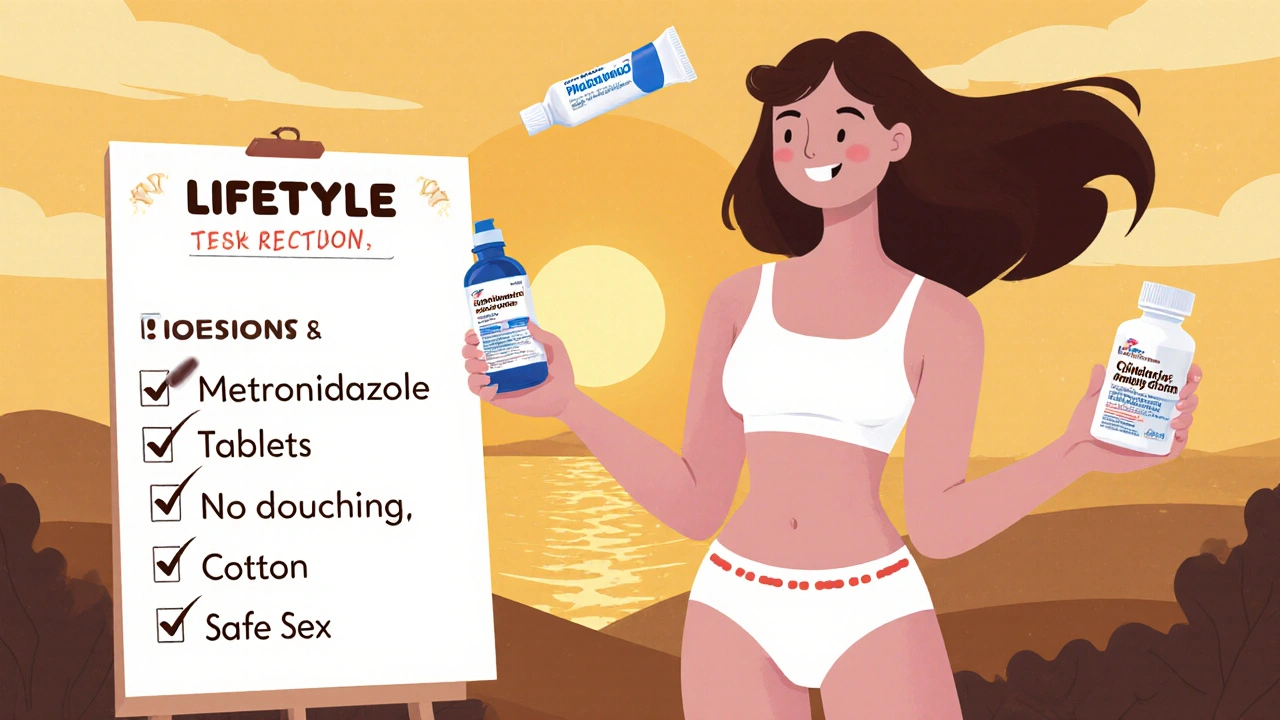BV Symptom Assessment Tool
This tool helps you assess potential BV symptoms based on information from the article. It is not a medical diagnosis.
Enter your symptoms to see your risk assessment.
Imagine feeling a strange discharge, itching, or a fish‑like odor and simply shrugging it off as a minor annoyance. For many women, that choice can turn a short‑lived discomfort into a lingering health issue. bacterial vaginosis isn’t just another vague term you hear at a doctor’s office-catching it early can spare you from complications that affect fertility, pregnancy, and overall well‑being.
What Is Bacterial Vaginosis?
When you first hear the name, you might wonder if it’s an infection, a disease, or something in between. In plain language, Bacterial Vaginosis is a shift in the natural balance of vaginal bacteria. Normally, Lactobacillus dominates, keeping the environment slightly acidic (pH around 3.8‑4.5) and preventing harmful microbes from taking hold.
When that balance tips-often because of a surge in Gardnerella vaginalis and other anaerobes-the protective acidity drops, allowing overgrowth that leads to the classic symptoms of BV.
Why Early Detection Matters
Spotting BV in its early stage isn’t a matter of vanity; it’s a health safeguard. Studies from the CDC show that untreated BV raises the risk of pelvic inflammatory disease (PID) by up to 70 %. That means a higher chance of chronic pelvic pain, infertility, and even ectopic pregnancy.
Pregnant women face an added layer of risk. BV has been linked to preterm birth, low birth weight, and premature rupture of membranes. Early diagnosis can allow clinicians to intervene before the pregnancy reaches a critical point.
Beyond the physical, there’s a psychological cost. Persistent odor or discharge can erode confidence and strain intimate relationships. Addressing BV quickly restores comfort and peace of mind.
Common Symptoms & How to Spot Them
- Thin, gray‑white discharge that may appear watery
- Fishy odor, especially after sex or during menstruation
- Itching or burning is less common but can occur
- No visible sores, bumps, or thick clumpy discharge (that points more toward a yeast infection)
If you notice any of these signs, don’t wait for them to disappear. A quick self‑check-looking at color, texture, and smell-can be the first step toward professional care.

Diagnostic Methods
Doctors have three main tools to confirm BV:
- Amsel’s criteria: a clinician checks for discharge, odor, pH > 4.5, and the presence of clue cells under a microscope.
- Gram stain: lab analysis that identifies the bacterial mix, highlighting the drop in Lactobacillus and rise in anaerobes.
- Nucleic acid amplification tests (NAAT): modern DNA‑based tests that pinpoint Gardnerella and other players with high accuracy.
Most clinics use a combination of Amsel’s criteria and a quick pH test on a litmus strip-fast, cheap, and reliable.
Treatment Options
Once diagnosed, the good news is that BV responds well to antibiotics. The two most common prescription routes are oral tablets and intravaginal gels or creams.
| Medication | Form | Typical Duration | Success Rate | Key Side Effects |
|---|---|---|---|---|
| Metronidazole | Oral tablet | 7 days | ≈ 80‑90 % | Nausea, metallic taste |
| Clindamycin | Vaginal cream | 5‑7 days | ≈ 85 % | Local irritation, rare fungal overgrowth |
| Probiotic adjunct | Oral capsule | 30 days (post‑antibiotic) | Improves recurrence rates | Generally none |
Metronidazole, the go‑to oral option, works by disrupting bacterial DNA. Clindamycin, applied directly to the vagina, sidesteps systemic exposure but can promote yeast overgrowth if used alone.
Many providers now recommend a short course of Probiotics after antibiotics to restore Lactobacillus levels and cut recurrence rates, which hover around 30 % within six months.
Risks of Untreated BV
Leaving BV unchecked is like ignoring a leaking pipe-you may not see the damage right away, but it spreads.
- Pelvic inflammatory disease (PID): Chronic infection can ascend to the uterus, fallopian tubes, and ovaries, causing scarring.
- HIV acquisition: The altered vaginal environment makes it easier for HIV to cross the mucosal barrier.
- Pregnancy complications: Preterm labor, low birth weight, and increased cesarean rates.
- Increased susceptibility to other STIs: BV can mask or exacerbate symptoms of chlamydia, gonorrhea, and HPV.
Recognizing these downstream effects underscores why a simple office visit can prevent far‑more serious interventions later.

Prevention & Lifestyle Tips
While you can’t control everything, a few habits go a long way:
- Avoid douching. It strips away protective Lactobacillus and invites anaerobes.
- Wear breathable cotton underwear; synthetic fabrics trap moisture.
- Limit scented soaps or feminine wipes-fragrances disrupt the pH balance.
- Practice safe sex. Using condoms reduces the exchange of bacterial flora.
- Consider regular probiotic intake, especially after antibiotics.
These steps keep the vaginal ecosystem stable, lowering the odds of a sudden bacterial surge.
When to Seek Professional Care
If you experience any of the following, book an appointment promptly:
- Persistent odor or discharge for more than a few days
- Pain during intercourse or urination
- Recent pregnancy or trying to conceive
- History of recurrent BV (four or more episodes in a year)
A quick office visit can confirm the diagnosis, start treatment, and discuss a personalized prevention plan.
Quick Takeaways
- Bacterial Vaginosis is a common, treatable bacterial imbalance.
- Early detection prevents PID, pregnancy complications, and increased STI risk.
- Typical symptoms: thin gray‑white discharge and a fishy smell.
- First‑line treatments: oral Metronidazole or vaginal Clindamycin, often followed by probiotics.
- Prevention: avoid douching, wear breathable underwear, and maintain a healthy vaginal pH.
Can a yeast infection be mistaken for bacterial vaginosis?
Yes, both can cause discharge, but a yeast infection typically produces a thick, white, cottage‑cheese‑like coating and intense itching, while BV’s discharge is thinner, gray‑white, and accompanied by a fishy odor. A simple pH test (BV > 4.5, yeast ≤ 4.5) helps differentiate them.
Is bacterial vaginosis contagious?
BV isn’t classified as a classic sexually transmitted infection, but sexual activity can shift bacterial balance, making partners a factor in recurrence. Using condoms and avoiding multiple partners reduces this risk.
How long does treatment for BV usually last?
Standard regimens run 5‑7 days. Some clinicians prescribe a longer 14‑day course for recurrent cases. Follow‑up testing isn’t always required unless symptoms persist.
Can I use over‑the‑counter products for BV?
OTC products like boric acid suppositories may alleviate symptoms, but they don’t replace prescription antibiotics. Talk to a healthcare provider before trying them.
What lifestyle changes help prevent BV recurrence?
Stop douching, wear cotton underwear, limit scented hygiene products, practice safe sex, and consider a daily probiotic containing Lactobacillus strains after completing antibiotics.


Vijaypal Yadav
October 20, 2025 AT 20:48While many people dismiss a fish‑like odor as merely inconvenient, it actually signals a shift in the vaginal microbiome that can have downstream effects on fertility. The Lactobacillus‑dominant environment maintains a low pH, and when Gardnerella overgrows, that protective acidity rises above 4.5. Studies have linked untreated BV to pelvic inflammatory disease, which can scar the fallopian tubes and hinder conception. Early detection through a simple pH strip or Amsel’s criteria can therefore prevent a cascade of complications. If you notice gray‑white discharge persisting beyond a few days, seeking a brief clinical assessment is a prudent step.
Andrew Hernandez
October 27, 2025 AT 18:43Short pH test, quick fix.
Alex Pegg
November 3, 2025 AT 17:40People act like BV is some exotic plague, but it’s basically a bacterial imbalance you can treat with a pill. Blaming partners for recurrence only fuels paranoia.
JessicaAnn Sutton
November 10, 2025 AT 16:36The clinical guidelines are unequivocal: metronidazole administered orally for seven days restores the Lactobacillus dominance in the majority of cases. Oral therapy circumvents the potential for local irritation associated with intravaginal creams. Nevertheless, clinicians must counsel patients about possible side‑effects such as metallic taste and nausea. Adherence to the full course is essential to minimize recurrence.
jessie cole
November 17, 2025 AT 15:33Dear reader, I understand how unsettling a lingering odor can be, and I commend you for taking steps toward resolution. Remember that the vaginal ecosystem thrives on balance, not harsh chemicals. A brief course of prescribed antibiotics, followed by a probiotic regimen, often restores harmony. Your confidence will thank you.
Ron Lanham
November 24, 2025 AT 14:30It is a moral imperative, especially for women of reproductive age, to take bacterial vaginosis seriously rather than treating it as a minor inconvenience. The epidemiological data from the CDC reveal a clear correlation between untreated BV and a 70% increase in pelvic inflammatory disease, a condition that can irrevocably damage the reproductive tract. Moreover, the risk of preterm birth and low birth weight among pregnant patients is not merely a statistic; it represents real infants entering the world under duress. The pathophysiology is straightforward: an overgrowth of anaerobic bacteria raises vaginal pH, diminishing the protective lactobacilli that normally fend off pathogen colonization. When this equilibrium is disturbed, the immune response is altered, facilitating the ascent of infection into the upper genital tract. This cascade culminates in scarring, infertility, and, in severe cases, chronic pelvic pain that can dominate a woman’s quality of life. It is not enough to occasionally self‑diagnose and hope the symptoms will vanish; the window for early intervention is narrow, and the consequences of delay are profound. Healthcare providers should employ Amsel’s criteria alongside a simple pH test, because these tools are inexpensive and highly effective. Therapeutic regimens such as a seven‑day course of metronidazole or clindamycin cream have success rates approaching ninety percent when taken as directed. Yet the treatment does not end with antibiotics; a probiotic supplement can re‑populate the vagina with beneficial lactobacilli, decreasing the likelihood of recurrence. Recurrence rates hover near thirty percent within six months, underscoring the need for post‑treatment maintenance. In addition, patients should be counseled to avoid douching, scented hygiene products, and tight synthetic underwear, all of which exacerbate dysbiosis. The broader public health perspective also demands attention: untreated BV may increase susceptibility to HIV acquisition, a fact that reverberates through communities. Therefore, every clinician must prioritize timely screening, especially in sexually active individuals and those planning pregnancy. The collective responsibility to educate and empower women with accurate information cannot be overstated, for the stakes are simply too high.
barnabas jacob
December 1, 2025 AT 13:26Yo bro, the microflora shift u talk ‘bout is basically a dysbiose event where anaerobes like Gardnerella spp dominate, causing a pH spikes >4.5. If you don’t re‑establish the lactobacilli via probiotic adjuncts, the biofilm persistence leads to recurrent BV episodes. Also, the enzymatic activity of sialidases and proteases from Gardnerella degrade mucosal barriers, upping STI risk. So yeah, compliance + post‑abx probiotic = best practice.
Rajesh Myadam
December 8, 2025 AT 12:23I hear you, and I’ve seen many patients feel relieved after a short antibiotic course followed by daily probiotic capsules. It’s also helpful to remind them that lifestyle tweaks-like switching to cotton underwear-can reinforce the treatment. Compassion and clear instructions go a long way in preventing recurrence.
laura wood
December 15, 2025 AT 11:20Your summary hits the key points perfectly; early detection truly saves a lot of downstream trouble. Thanks for laying it out so clearly.
Kate McKay
December 22, 2025 AT 10:16For anyone reading this, remember that you are not alone in dealing with BV. A simple over‑the‑counter pH test can give you a quick clue before you schedule a doctor’s visit. If the test reads above 4.5, it’s a sign that the protective acid environment has been compromised. Discuss with your clinician about the appropriate antibiotic-metronidazole is usually first‑line-and don’t forget to ask about a probiotic plan afterward. Small changes in daily habits can make a huge difference.